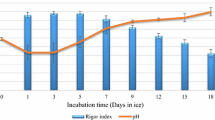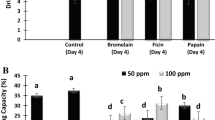Abstract
The effect of three protein sources (sardine-based diet, squid-based diet and commercial diet) in feed on white shrimp (Litopenaeus vannamei) growth, muscle collagen, collagenase activity and shear force was determined. Shrimp fed on diets with squid and sardine protein exhibited greater growth (p<0.05) than those fed with commercial feed. Shrimp muscle collagen obtained from each treatment group showed similar molecular weight to that of bovine collagen type I as determined by sodium dodecyl sulfate- polyacrylamide gel electrophoresis (SDS-PAGE). Denaturation thermograms by differential scanning calorimetry (DSC) for shrimp collagen showed a transition peak at 47 °C, whereas that for bovine collagen type I was 65 °C. The lowest enthalpy of transition was detected in collagen from shrimp fed on squid. The highest muscle collagenase activity was detected in shrimp fed with commercial feed. After 10-day ice storage, muscle from shrimp fed commercial feed required somewhat less shear force than those fed with sardine-based and squid-based meal. The results suggest that the source of protein influences the enthalpy of transition of collagen from shrimp muscle, collagenase activity, and texture in shrimp tail meat as well as growth rate.

Similar content being viewed by others
References
SEMARNAT (2000) Anuario estadísitico de pesca.http:// semarnat.gob.mx/ sspesca/ anua98/ anua98.htm
Pike IH, Hardy RW (1997) Standard for assessing quality of feed ingredients. In: Abramo LR, Conklin DE (eds) Crustacean nutrition, advances in world aquaculture. World Aquaculture Society, Louisiana, pp 473–489
Rivas-Vega ME, Rouzaud-Sandez O, Martínez-Córdova LR, Ezquerra-Brauer JM (2001) J Aquatic Food Product Technol 10:25–38
Love RM, Lavety JY, Vellas F (1982) Unusual properties of the connective tissue of cod (Gadus morhua). In: Martin RE, Flick GJ, Hebard CE, Ward DR (eds) Chemistry and biochemistry of marine food products. AVI Publishing, Weport Connecticut, USA, pp67–72
Lindner P, Angel S, Granit R (1988) Food Chem 29:119–132
Salame M (1993). Aquaculuture Mag 19:59–63
Kimura S, Tanaka H (1986). J Food Sci 51:330–339
Laemmli UK (1970). Nature London 227:680–685
Doke SN, Ninjoor V (1987) J Food Sci 52:1203–1208
Hartree EF (1972) Anal Biochem 48:422–427
Stauffer C (1989) Enzymes assays for food scientists. Van Nostradn Reinhol/AVI, New York, USA
Kim H (1991) Characterization and potential utilization of protease from hepatopancreas of crawfish (Procamborus clarkii). Ph D. Thesis. Lousiana, State University, USA
Srinivasan S, Xiong YL, Suzzanes P, Tidwell JH (1997) J Food Sci 62:123–127
Statsoft (2000) Statsoft, Inc. Tulsa, Okla., USA
Sudaryono A, Hoxey MJ, Kailis SG, Evans LH (1995) Aquaculture 134:313–323
Akiyama DM, Dominy WG, Lawrence A (1992) Penaeus shrimp nutrition. In: Fast AW, Lester J (eds) Marine shrimp culture: Principles and practices. Elsevier Science, pp 535–567
Simpson BK (1997) Innovation strategies for controlling fresh fish texture degradation during postharvest handling and storage. In: Shahidi F, Jones Y, Kitts DD (eds) Seafood safety processing and biotechnology. Technomic, Switzerland, pp 161–177
Acknowledgements
The authors thank Dr. Norman F. Haard (UC-Davis) and Dr. Armando Burgos-Hernández, (DIPA-UNISON) for their suggestions and English-language text editing. This study was supported by Grant 31600-B from CONACYT given to Josafat Marina Ezquerra Brauer and a scholarship given to Jesús Aarón Salazar Leyva.
Author information
Authors and Affiliations
Corresponding author
Rights and permissions
About this article
Cite this article
Ezquerra Brauer, J.M., Salazar Leyva, J.A., Bringas Alvarado, L. et al. Effect of dietary protein on muscle collagen, collagenase and shear force of farmed white shrimp (Litopenaeus vannamei). Eur Food Res Technol 217, 277–280 (2003). https://doi.org/10.1007/s00217-003-0739-7
Received:
Revised:
Published:
Issue Date:
DOI: https://doi.org/10.1007/s00217-003-0739-7




